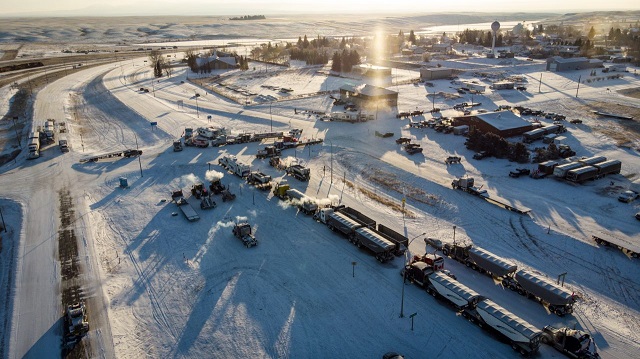Alberta
‘Coutts Two’ Verdict: Bail and Mischief

Protesters demonstrating against COVID-19 mandates and restrictions gather as a truck convoy blocks the highway at the Canada-U.S. border crossing in Coutts, Alta., on Feb. 2, 2022. The Canadian Press/Jeff McIntosh
From the Frontier Centre for Public Policy
By Ray McGinnis
Imagine spending over two years behind bars, only to be told the evidence never supported the charges against you.
On Aug. 2, a Lethbridge jury found Chris Carbert and Tony Olienick not guilty of the most serious charge of conspiracy to commit murder of police officers. However, though they were declared innocent, the conspiracy charge was the basis for their being held in remand for at least 925 days. They were denied bail based on this charge.
The sentencing hearing for other charges against Carbert and Olienick is taking place this week.
Granting Bail Typical for Serious Offences
In Canada, when someone is charged with committing a crime, they’re released on bail. This includes those charged with murder. For example, in September 2021, 31-year-old Umar Zameer was released on bail after being charged with the first-degree murder of Toronto Police Constable Jeffrey Northrup.
A case of double murder in the city of Mission in B.C.’s Fraser Valley concerned the deaths of Lisa Dudley and her boyfriend Guthrie McKay. Tom Holden, accused of first-degree murder in the case, was released on bail.
Conditions for not Granting Bail
Why do we release people from custody after being charged with a crime? Why don’t we hold people indefinitely? It’s been a Canadian tradition that there’s a process in place to which we adhere. Does the person charged with a crime seem to present a risk of repeating an offence? Carbert and Olienick hadn’t previously committed the offence(s) they were charged with. They didn’t have any criminal records for any violence. So, the likelihood of repetition of offence didn’t apply.
Another reason for denying bail is flight risk. But the Crown agreed neither of these men posed a flight risk. If you’re not clear about the identity of the person you’ve arrested, you can hold them in custody. But the Crown and the RCMP were certain of the identity of these men.
How about denying bail for evidence protection? If let go, was it possible the Crown or RCMP would lose evidence, and they needed to keep Carbert and Olienick in remand? No.
Were Carbert or Olienick considered a danger to the public? No. They had no past history of committing violent crimes, so in the case of the Coutts Two this was not a reason to deny bail.
The Crown insisted the pair be denied bail because their release would undermine confidence in the judicial system. Due to the seriousness of the offences the pair were charged with, releasing them would put the legal system into disrepute. But this is a circular argument. In authoritarian countries, police may arrest citizens on serious charges they’re not guilty of and leave them in prison indefinitely.
Granting Bail Goes Back to Magna Carta
Since the Magna Carta was signed in 1215, western judicial institutions have allowed those charged with a crime to be presumed innocent until proven guilty. With that provision comes the right to bail and a speedy trial. When citizens are accused of a crime and left to rot in prison without having their day in court, their spirits can be broken and persuaded to agree to plead guilty even when they are innocent.
Unindicted Co-conspirators Never Interviewed
During the trial, the Crown repeatedly named a list of unindicted co-conspirators. Each had a licence to carry a weapon in public for years. None of them were ever searched. None of them were ever interviewed. None of the alleged co-conspirators received any communication from the RCMP, or other authorities, about their possible connection to a conspiracy to murder police officers. However, the list of names provided for some legal theatre in the court added to the ominous scale of the supposed conspiracy to murder police officers.
Intelligence
Former career police officer Vincent Gircys had standing in the Justice Mosley decision. The judge ruled in January 2024 that the government’s invocation of the Emergencies Act in February 2022 to end the convoy protests was unconstitutional.
After the Coutts Two verdict, Gircys was concerned about the intelligence. There was a disconnect between the conspiracy charge and the evidence the Crown brought to trial. Gircys stated, “It’s really important to find where that disconnect is. Because of faulty intelligence? False intelligence? Fabricated intelligence? The evidence that they (RCMP) do have would all be logged, gathered, and time-lined. And that goes to what evidence was not gathered? … How could that information have been laid in the first place? How could the Crown have proceeded with this case to begin with?”
The Coutts Two were found not guilty of conspiracy to commit murder. But by the time they are sentenced on the other charges this week, they will have spent at least 925 days in custody. What does this mean for innocent until proven guilty?
Ray McGinnis is a Senior Fellow with the Frontier Centre for Public Policy. His forthcoming book is “Unjustified: The Emergencies Act and the Inquiry that Got It Wrong.”
Alberta
Alberta takes big step towards shorter wait times and higher quality health care

From the Fraser Institute
On Monday, the Smith government announced that beginning next year it will change the way it funds surgeries in Alberta. This is a big step towards unlocking the ability of Alberta’s health-care system to provide more, better and faster services for the same or possibly fewer dollars.
To understand the significance of this change, you must understand the consequences of the current (and outdated) approach.
Currently, the Alberta government pays a lump sum of money to hospitals each year. Consequently, hospitals perceive patients as a drain on their budgets. From the hospital’s perspective, there’s little financial incentive to serve more patients, operate more efficiently and provide superior quality services.
Consider what would happen if your local grocery store received a giant bag of money each year to feed people. The number of items would quickly decline to whatever was most convenient for the store to provide. (Have a favourite cereal? Too bad.) Store hours would become less convenient for customers, alongside a general decline in overall service. This type of grocery store, like an Alberta hospital, is actually financially better off (that is, it saves money) if you go elsewhere.
The Smith government plans to flip this entire system on its head, to the benefit of patients and taxpayers. Instead of handing out bags of money each year to providers, the new system—known as “activity-based funding”—will pay health-care providers for each patient they treat, based on the patient’s particular condition and important factors that may add complexity or cost to their care.
This turns patients from a drain on budgets into a source of additional revenue. The result, as has been demonstrated in other universal health-care systems worldwide, is more services delivered using existing health-care infrastructure, lower wait times, improved quality of care, improved access to medical technologies, and less waste.
In other words, Albertans will receive far better value from their health-care system, which is currently among the most expensive in the world. And relief can’t come soon enough—for example, last year in Alberta the median wait time for orthopedic surgeries including hip and knee replacements was 66.8 weeks.
The naysayers argue this approach will undermine the province’s universal system and hurt patients. But by allowing a spectrum of providers to compete for the delivery of quality care, Alberta will follow the lead of other more successful universal health-care systems in countries such as Australia, Germany, the Netherlands and Switzerland and create greater accountability for hospitals and other health-care providers. Taxpayers will get a much better picture of what they’re paying for and how much they pay.
Again, Alberta is not exploring an untested policy. Almost every other developed country with universal health care uses some form of “activity-based funding” for hospital and surgical care. And remember, we already spend more on health care than our counterparts in nearly all of these countries yet endure longer wait times and poorer access to services generally, in part because of how we pay for surgical care.
While the devil is always in the details, and while it’s still possible for the Alberta government to get this wrong, Monday’s announcement is a big step in the right direction. A funding model that puts patients first will get Albertans more of the high-quality health care they already pay for in a timelier fashion. And provide to other provinces an example of bold health-care reform.
Alberta
Alberta’s embrace of activity-based funding is great news for patients

 From the Montreal Economic Institute
From the Montreal Economic Institute
Alberta’s move to fund acute care services through activity-based funding follows best practices internationally, points out an MEI researcher following an announcement made by Premier Danielle Smith earlier today.
“For too long, the way hospitals were funded in Alberta incentivized treating fewer patients, contributing to our long wait times,” explains Krystle Wittevrongel, director of research at the MEI. “International experience has shown that, with the proper funding models in place, health systems become more efficient to the benefit of patients.”
Currently, Alberta’s hospitals are financed under a system called “global budgeting.” This involves allocating a pre-set amount of funding to pay for a specific number of services based on previous years’ budgets.
Under the government’s newly proposed funding system, hospitals receive a fixed payment for each treatment delivered.
An Economic Note published by the MEI last year showed that Quebec’s gradual adoption of activity-based funding led to higher productivity and lower costs in the province’s health system.
Notably, the province observed that the per-procedure cost of MRIs fell by four per cent as the number of procedures performed increased by 22 per cent.
In the radiology and oncology sector, it observed productivity increases of 26 per cent while procedure costs decreased by seven per cent.
“Being able to perform more surgeries, at lower costs, and within shorter timelines is exactly what Alberta’s patients need, and Premier Smith understands that,” continued Mrs. Wittevrongel. “Today’s announcement is a good first step, and we look forward to seeing a successful roll-out once appropriate funding levels per procedure are set.”
The governments expects to roll-out this new funding model for select procedures starting in 2026.
* * *
The MEI is an independent public policy think tank with offices in Montreal, Ottawa, and Calgary. Through its publications, media appearances, and advisory services to policymakers, the MEI stimulates public policy debate and reforms based on sound economics and entrepreneurship.
-

 2025 Federal Election17 hours ago
2025 Federal Election17 hours agoRCMP memo warns of Chinese interference on Canadian university campuses to affect election
-

 2025 Federal Election1 day ago
2025 Federal Election1 day agoConservative Party urges investigation into Carney plan to spend $1 billion on heat pumps
-

 2025 Federal Election1 day ago
2025 Federal Election1 day agoFifty Shades of Mark Carney
-

 Alberta1 day ago
Alberta1 day agoAlberta takes big step towards shorter wait times and higher quality health care
-

 2025 Federal Election1 day ago
2025 Federal Election1 day agoCorporate Media Isn’t Reporting on Foreign Interference—It’s Covering for It
-

 Business1 day ago
Business1 day agoTrump raises China tariffs to 125%, announces 90-day pause for countries who’ve reached out to negotiate
-

 2025 Federal Election16 hours ago
2025 Federal Election16 hours agoThe status quo in Canadian politics isn’t sustainable for national unity
-

 Business17 hours ago
Business17 hours agoScott Bessent Says Trump’s Goal Was Always To Get Trading Partners To Table After Major Pause Announcement







